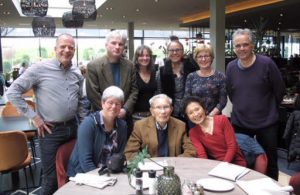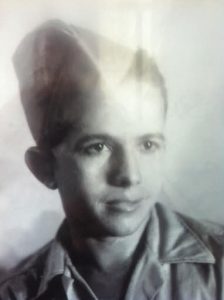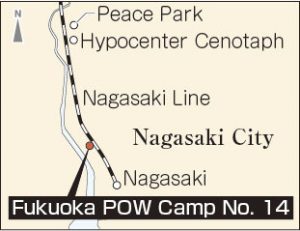Families of A-bombed former Dutch POWs plan to erect monument in Nagasaki next spring in appeal for peace and friendship
Jan. 20, 2020
(by Miho Kuwajima, Staff Writer)
Families of former Dutch POWs who were captured by the Imperial Japanese Army during World War II and experienced the atomic bombing in Fukuoka POW Camp No. 14 in Nagasaki are formulating plans to erect a monument in the city. They hope the effort will etch into history the story of how the Allied POWs were A-bombed while suffering extreme hardship and forced labor, and at the same time, spread the importance of peace and friendship.
Rob Schouten, 61, who lives in the Netherlands, is a leading member of the monument project. The monument will be made of iron imbued with motifs of identification tags worn by the POWs and folded-paper cranes. Through a local resident who supports the project, the group has requested cooperation from Nagasaki City. The group is now moving ahead with the work of site selection with the aim of erecting the monument in the spring of next year.
Shigeaki Mori, 82, an A-bomb survivor and resident of Hiroshima’s Nishi Ward, continues his search for family members of Dutch POWs who died in the Nagasaki atomic bombing. To that end, he provides relevant materials and documents to support the project. “The project helps get the message out that the POWs who survived continued to suffer from the effects of exposure to the atomic bombing even after returning home.”
Mr. Schouten’s father, Everhard, died in 2012 at the age of 90. He was born in the Dutch East Indies (now Indonesia). In 1943, he was captured by the Imperial Japanese Army and sent as a POW to Nagasaki, where two years later he experienced the atomic bombing on August 9. After the war, he lived in the Netherlands.
Mr. Schouten was 15 years old when his father first told him about his A-bombing experience. “I was shocked when I found out he witnessed the destruction caused by the most devastating weapon in the world.” Five years ago, Mr. Schouten and Willy Buchel, another former POW and A-bomb survivor, formed Project Nagasaki 2020. Mr. Buchel died in July 2019 at the age of 99, but about 10 project members, including Mr. Schouten, continue working to fulfill the late Mr. Buchel’s wish to erect the monument in commemoration of his comrades.
Camp No. 14 was established in April 1943 on the grounds of the Mitsubishi Heavy Industries Saiwaimachi Plant, about 1.7 kilometers from the hypocenter. Seven Dutch and one British POW are thought to have died in the atomic bombing, with 30–50 POWs injured. According to POW Research Network Japan, a citizens’ group based in Tokyo that investigates the circumstances of prisoners of war, 195 Allied POWs, including Australian soldiers, were held at the end of the war.
During the war, the Imperial Japanese Army captured and interned Allied military personnel in Indonesia, Singapore, and elsewhere. Beginning in 1942, such POWs were transported to about 130 camps in Japan, including one in the city of Miyoshi, Hiroshima prefecture. More than 30,000 people were held in the camps and forced to labor under severe conditions.
The cost of erecting the monument is expected to be approximately 63,000 euro (about 7.8 million yen). In addition to grants from Dutch government agencies and private organizations, the group is raising funds through crowdfunding at: www.whydonate.nl/fundraising/monument‐pow‐kamp‐fukuoka‐14).
Yoko Watanuki, 60, is a project member who lives in the Netherlands. “The Dutch still have mixed feelings toward Japan,” she said. “I truly hope the monument can help lead to reconciliation.” As for Mr. Schouten, he is calling for cooperation. “I want the world to remember the POWs who led a hard life and were victimized in the atomic bombing.”
(Originally published on January 20, 2020)
Families of former Dutch POWs who were captured by the Imperial Japanese Army during World War II and experienced the atomic bombing in Fukuoka POW Camp No. 14 in Nagasaki are formulating plans to erect a monument in the city. They hope the effort will etch into history the story of how the Allied POWs were A-bombed while suffering extreme hardship and forced labor, and at the same time, spread the importance of peace and friendship.
Rob Schouten, 61, who lives in the Netherlands, is a leading member of the monument project. The monument will be made of iron imbued with motifs of identification tags worn by the POWs and folded-paper cranes. Through a local resident who supports the project, the group has requested cooperation from Nagasaki City. The group is now moving ahead with the work of site selection with the aim of erecting the monument in the spring of next year.
Shigeaki Mori, 82, an A-bomb survivor and resident of Hiroshima’s Nishi Ward, continues his search for family members of Dutch POWs who died in the Nagasaki atomic bombing. To that end, he provides relevant materials and documents to support the project. “The project helps get the message out that the POWs who survived continued to suffer from the effects of exposure to the atomic bombing even after returning home.”
Mr. Schouten’s father, Everhard, died in 2012 at the age of 90. He was born in the Dutch East Indies (now Indonesia). In 1943, he was captured by the Imperial Japanese Army and sent as a POW to Nagasaki, where two years later he experienced the atomic bombing on August 9. After the war, he lived in the Netherlands.
Mr. Schouten was 15 years old when his father first told him about his A-bombing experience. “I was shocked when I found out he witnessed the destruction caused by the most devastating weapon in the world.” Five years ago, Mr. Schouten and Willy Buchel, another former POW and A-bomb survivor, formed Project Nagasaki 2020. Mr. Buchel died in July 2019 at the age of 99, but about 10 project members, including Mr. Schouten, continue working to fulfill the late Mr. Buchel’s wish to erect the monument in commemoration of his comrades.
Camp No. 14 was established in April 1943 on the grounds of the Mitsubishi Heavy Industries Saiwaimachi Plant, about 1.7 kilometers from the hypocenter. Seven Dutch and one British POW are thought to have died in the atomic bombing, with 30–50 POWs injured. According to POW Research Network Japan, a citizens’ group based in Tokyo that investigates the circumstances of prisoners of war, 195 Allied POWs, including Australian soldiers, were held at the end of the war.
During the war, the Imperial Japanese Army captured and interned Allied military personnel in Indonesia, Singapore, and elsewhere. Beginning in 1942, such POWs were transported to about 130 camps in Japan, including one in the city of Miyoshi, Hiroshima prefecture. More than 30,000 people were held in the camps and forced to labor under severe conditions.
The cost of erecting the monument is expected to be approximately 63,000 euro (about 7.8 million yen). In addition to grants from Dutch government agencies and private organizations, the group is raising funds through crowdfunding at: www.whydonate.nl/fundraising/monument‐pow‐kamp‐fukuoka‐14).
Yoko Watanuki, 60, is a project member who lives in the Netherlands. “The Dutch still have mixed feelings toward Japan,” she said. “I truly hope the monument can help lead to reconciliation.” As for Mr. Schouten, he is calling for cooperation. “I want the world to remember the POWs who led a hard life and were victimized in the atomic bombing.”
(Originally published on January 20, 2020)










